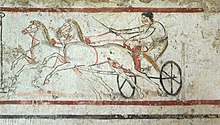Lucania


Lucaniawas a historical region ofSouthern Italy,corresponding to the modern-day region ofBasilicata.It was the land of theLucani,anOscanpeople. It extended from theTyrrhenian Seato theGulf of Taranto.It bordered withSamniumandCampaniain the north,Apuliain the east, andBruttiumin the south-west, and was at the tip of the peninsula which is now calledCalabria.It comprised almost all the modern region ofBasilicata,the southern part of theProvince of Salerno(theCilentoarea) and a northern portion of theProvince of Cosenza.
The precise limits were the riverSilarusin the north-west, which separated it from Campania, and theBradanuswhich flows into the Gulf of Taranto in the east. The lower tract of the riverLaus,which flows from a ridge of theApennine Mountainsto the Tyrrhenian Sea in an east-west direction, marked part of the border with Bruttium.
Geography[edit]
Almost the whole area is occupied by theApennine Mountains,which here are an irregular group of lofty masses. The main ridge approaches the western sea and continues from the lofty knot of mountains on the frontiers ofSamnium,in a mostly southerly direction, to within a few miles of theGulf of Policastro.From then on it is separated from the sea by only a narrow interval until it entersBruttium.
Just within the frontier of Lucania risesMonte Pollino,7,325 ft (2,233 m), the highest peak in the southernApennines.The mountains descend in a much more gradual slope to the coastal plain of theGulf of Taranto.Thus the rivers which flow to theTyrrhenian Seaare of little importance compared with those that descend towards the Gulf of Tarentum. Of these the most important are the Bradanus (Bradano), the Casuentus (Basento), the Aciris (Agri), and theSiris(Sinni).
TheCrathis,which forms at its mouth the southern limit of the province, belongs almost wholly to the territory of theBruttii,but it receives a tributary, theSybaris(Coscile), from the mountains of Lucania. The only considerable stream on the western side is the Silarus (Sele), which constitutes the northern boundary, and has two important tributaries in the Calor (Calore Lucanoor Calore Salernitano) and the Tanager (Tanagroor Negro) which joins it from the south.
Etymology[edit]
Historians at University of Naples Eastern Studies concluded that the root of the name Lucania is derived fromluc,the Osco-Sabellic peoples word for light, which has the same meaning in the Latin idiom. The people that moved from the Osco-Sabellic tribes to occupy the land east of the Sillaro River, which was an area associated with the morning star, Lucifer (Latin for bringer of light). Therefore, Lucania means eastern land or land from which there is light.[2]The study also explains why it is not Greek in origin. As noted in the History section on this page, the Greeks referred to this region of Italy as Oenotria.
History[edit]
Antiquity[edit]

The district of Lucania was so called from the people bearing the nameLucani(Lucanians) by whom it was conquered about the middle of the 5th century BC. Before that period it was included under the general name ofOenotria,which was applied by the Greeks to the southernmost portion of Italy.
The mountainous interior was occupied by the tribes known asOenotriansand Choni, while the coasts on both sides were occupied by powerfulGreek colonieswhich doubtless exercised a protectorate over the interior (seeMagna Graecia). The Lucanians were a southern branch of theSamniteorSabellicpeople, who spoke theOscanlanguage. They had a democratic constitution save in time of war, when adictatorwas chosen from among the regular magistrates.
A fewOscan inscriptionssurvive, mostly inGreek charactersfrom the 4th or 3rd century BC, and somecoinswith Oscan legends of the 3rd century.[3]The Lucanians gradually conquered the whole country (with the exception of the Greek towns on the coast) from the borders ofSamniumandCampaniato the southern extremity ofItaly.Subsequently the inhabitants of the peninsula, now known asCalabria,broke into insurrection, and under the name ofBruttiansestablished their independence, after which the Lucanians became confined within the limits already described.
After this we find them engaged in hostilities with theTarentines,and withAlexander,king ofEpirus,who was called in by that people to their assistance, 334 BC. In 298 BC (Livy x. II seq.) they made alliance withRome,and Roman influence was extended by the colonies ofVenusia(291 BC),Paestum(273), and above allTarentum(272).
Subsequently they were sometimes in alliance, but more frequently engaged in hostilities, during theSamnite wars.On the landing ofPyrrhusin Italy (281 BC) they were among the first to declare in his favor, and found themselves exposed to the resentment of Rome when the departure of Pyrrhus left his allies at the mercy of the Romans. After several campaigns they were reduced to subjection (272 BC). Notwithstanding this they espoused the cause ofHannibalduring theSecond Punic War(216 BC), and their territory during several campaigns was ravaged by both armies. The country never recovered from these disasters, and under the Roman government fell into decay, to which theSocial War,in which the Lucanians took part with theSamnitesagainstRome(90–88 BC) gave the finishing stroke.
In the time ofStrabothe Greek cities on the coast had fallen into insignificance, and owing to the decrease of population and cultivation malaria began to obtain the upper hand. The few towns of the interior were of no importance. A large part of the province was given up to pasture, and the mountains were covered with forests, which abounded in wild boars, bears and wolves. There were some fifteen independent communities, but none of great importance.
For administrative purposes under theRoman empire,Lucania was always united with the district of the Bruttii, a practice continued byTheodoric.[4]The two together constituted the third region ofAugustus.
Middle Ages[edit]
After the fall of theWestern Roman Empirein 476 CE, Lucania fell toOdoacerand became part of theKingdom of Italybefore being turned into theKingdom of the Ostrogothsin 493 CE. Ostrogothic rule in the region was short lived due toJustinian’sreconquest of Italy in the mid-Sixth century. TheByzantineconquest reintroduced Greeks and Greek culture to the region. In the early 7th, Byzantine rule was cut short as another Germanic people, theLombardsconquered Lucania from the Byzantines and became part of theKingdom of the Lombards.In 774, after theFrankish invasion,Lucania became a part of the independentDuchy of Beneventoand later, underHoly Roman EmperorLouis II,part of the Duchy was turned into the independentPrincipality of Salernoin 851.
In the late 10th century the Byzantines began to re-enter the region of Lucania forming theCatapanate of Italywith Salerno being granted autonomy. By the early 11th century the Byzantine revival in Lucania came with both a process ofHellenizationand significant Greek migrations from southern and centralCalabriaandSalento,into regions such asCilento.Lucania would remain largely Greek till the 12th century when a gradual process of Latinization would occur. By the 14th century, there were few Greek inhabitants as the majority had been assimilated.[5][6][7]
In the mid-11th century, Lucania was conquered by theNormansfirst becoming theCounty of Apulia and Calabriathen becoming part of theKingdom of Sicilyin 1130. In 1194, Lucania would become part of the Holy Roman Empire under theHohenstaufen dynasty.After that theAngevinswould take control of Lucania in the mid-13th century before being part of theKingdom of Aragonin the 14th century after theWar of the Sicilian Vespers.
Cities and towns[edit]

The towns on the east coast wereMetapontum,a few miles south of the Bradanus;Heraclea,at the mouth of the Aciris; and Sins, on the river of the same name.
Close to its southern frontier stoodSybaris,which was destroyed in 510 BC, but subsequently replaced byThurii.On the west coast stood Posidonia, known under the Roman government asPaestum;below that came Elea (Veliaunder the Romans),Pyxus,called by the Romans Buxentum, andLaüs,near the frontier of the province towardsBruttium.
Of the towns of the interior the most considerable was Potentia, still calledPotenza.To the north, near the frontier of Apulia, wasBantia(Aceruntiabelonged more properly to Apulia); while due south from Potentia wasGrumentum,and still farther in that direction were Nerulum and Muranum.
In the upland valley of the Tanagrus wereAtina,Forum Popiliiand Consilinum (nearSala Consilina); Eburi (Eboli) and Volceii (Buccino), though to the north of theSilarus,were also included in Lucania.
TheVia Popiliatraversed the district from north to south, entering it at the northwestern extremity; theVia Herculia,coming southwards from theVia Appiaand passing through Potentia and Grumentum, joined theVia Popilianear the southwestern edge of the district: while another nameless road followed the east coast and other roads of less importance ran west from Potentia to theVia Popilia,northeast to theVia Appiaand east from Grumentum to the coast at Heraclea.
Later use[edit]
The modern nameBasilicataoriginates from the 10th century AD, when the area was underByzantinecontrol. During the early 19th century, during theCarbonari revolutionof 1820–21, the region was renamed and divided into Eastern and Western Lucania (Lucania OrientaleandLucania Occidentale). From the latter half of the 19th century some residents campaigned to reinstate that name.
In 1932 theFascist regimechanged the name to Lucania, as part of its appropriation of symbols from the Roman Empire. After the end of the war and Italy's defeat, the new government restored the name of Basilicata to the province in 1947. In the late 20th century, Lucania was still in vernacular use as a synonym to Basilicata.[8]
Notes[edit]
- ^"La sala delle costituzioni e la tomba del carro | Vulture mobile".Archived fromthe originalon 2024-02-24.
- ^"Come ti chiami? Lucania!!!".10 February 2016.
- ^seeConway,Italic Dialects,p. II sqq.;Mommsen,C.I.L.x. p. 2I;Roehl,Inscriptiones Graecae Antiquissimae, 547.
- ^Cassiodorus:Chapter 1, Backgrounds and Some DatesArchived2005-05-10 at theWayback Machine
- ^Loud, G. A. (2007).The Latin Church in Norman Italy.Cambridge University Press. p.494.ISBN978-0-521-25551-6.
At the end of the twelfth century... While in Apulia Greeks were in a majority – and indeed present in any numbers at all – only in the Salento peninsula in the extreme south, at the time of the conquest they had an overwhelming preponderance in Lucania and central and southern Calabria, as well as comprising anything up to a third of the population of Sicily, concentrated especially in the north-east of the island, the Val Demone.
- ^Oldfield, Paul (2014).Sanctity and Pilgrimage in Medieval Southern Italy, 1000–1200.Cambridge University Press. p. 13.ISBN978-1-107-00028-5.
However, the Byzantine revival of the tenth century generated a concomitant process of Hellenization, while Muslim raids in southern Calabria, and instability in Sicily, may also have displaced Greek Christians further north on the mainland. Consequently, zones in northern Calabria, Lucania and central Apulia which were reintegrated into Byzantine control also experienced demographic shifts, and the increasing establishment of immigrant Greek communities. These zones also acted as springboards for Greek migration further north, into regions such as the Cilento and areas around Salerno, which had never been under Byzantine control.
- ^Kleinhenz, Christopher (2004).Medieval Italy: an encyclopedia, Volume 1.Routledge. pp. 444–445.ISBN978-0-415-93930-0.
In Lucania (northern Calabria, Basilicata, and southernmost portion of today's Campania)... From the late ninth century into the eleventh, Greek-speaking populations and Byzantine temporal power advanced, in stages but by no means always in tandem, out of southern Calabria and the lower Salentine peninsula across Lucania and through much of Apulia as well. By the early eleventh century, Greek settlement had radiated northward and had reached the interior of the Cilento, deep in Salernitan territory. Parts of the central and north-western Salento, recovered early, came to have a Greek majority through immigration, as did parts of Lucania.
- ^Guida d'Italia: Basilicata, Calabria.Touring club italiano (1980)ISBN978-88-365-0021-5p. 11
References[edit]
- This article incorporates text from a publication now in thepublic domain:Chisholm, Hugh,ed. (1911). "Lucania".Encyclopædia Britannica.Vol. 17 (11th ed.). Cambridge University Press. p. 92.
